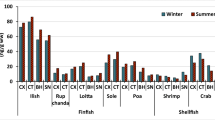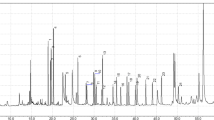Abstract
We evaluated the concentration and congener distribution of seven “target” polychlorinated biphenyls (PCBs) present in water collected in different aquaculture farms of the Mediterranean area, commercial feeds, and farmed seafood. PCBs were present in feed and in tissues of all the analysed organisms at levels ranging from 1.96 ng g−1 to 124.00 ng g−1 wet weight, and in 10.5% of the water samples, at levels from under detection limit to 33.0 ng l−1 with total PCB concentrations significantly higher in samples from the Tyrrhenian Sea than the Adriatic Sea. PCB congener distribution in tissues resembled that of feed, suggesting that commercial feed is an important source of PCBs. The estrogenicity of organic extracts of the samples was also evaluated by using an in vitro yeast reporter assay. Estrogenic activity higher than 10% of the activity induced by 10 nM 17 β-estradiol was observed in 20.0% of seafood samples and 15.8% of water samples. Seafood and water samples from the Tyrrhenian Sea were more frequently estrogenic than the Adriatic ones (16.45 versus 4.08%). A significant correlation of total PCB concentrations on biological activity was observed for sea bass and mussels from the Adriatic Sea (p < 0.045 and p < 0.04, respectively), and for sea bass of the Tyrrhenian Sea (p = 0.05). These results indicate the need of an integral approach in the exposure assessment to potential toxic compounds for human via food.
Similar content being viewed by others
References
Antunes, P., & Gil, O. (2004). PCB and DDT contamination in cultivated and wild sea bass from Ria de Aveiro, Portugal. Chemosphere, 54, 1503–1507.
Bayarri, S., Baldassarri, L. T., Iacovella, N., Ferrara, F., & di Domenico, A. (2001). PCDDs, PCDFs, PCBs and DDE in edible marine species from the Adriatic Sea. Chemosphere, 43, 601–610.
Bonefeld-Jørgensen, E. C., Andersen, H. R., Rasmussen, T. H., & Vinggaard, A. M. (2001). Effect of highly bioaccumulated polychlorinated biphenyl congeners on estrogen and androgen receptor activity. Toxicology, 158, 141–153.
Bonefeld-Jørgensen, E. C., & Ayotte, P. (2003). Toxicological properties of persistent organic pollutants and related health effects of concern for the Arctic populations. In AMAP 2003. AMAP Assessment 2002: Human health in the Arctic, Chapter 6. Arctic Monitoring and Assessment Programme (AMAP), Oslo, Norway 2003:xiv+137pp. Retrieved from: http://www.amap.no HH_CO6.pdf ISBN 82-7971-016-7.
Catalan, J., Ventura, M., Vives, I., & Grimalt, J. O. (2004). The roles of food and water in the bioaccumulation of organochlorine compounds in high mountain lake fish. Environmental Science and Technology, 38, 4269–4275.
Dewailly, E., & Weihe, P. (2003). The effect of Arctic pollution on population health. In AMAP 2003. AMAP Assessment 2002: Human health in the Arctic, Chapter 9. Arctic Monitoring and Assessment Programme (AMAP), Oslo, Norway 2003:xiv + 137pp. Retrieved from http://www.amap.no HH_CO9.pdf ISBN 82-7971-016-7.
Fernandez, M. A., Gomara, B., Bordajandi, L. R., Herrero, L., Abad, E., & Abalos, M., et al. (2004). Dietary intakes of polychlorinated dibenzo-p-dioxins, dibenzofurans and dioxin-like polychlorinated biphenyls in Spain. Food Additives and Contaminants, 21, 983–991.
Foran, J. A., Carpenter, D. O., Hamilton, M. C., Knuth, B. A., & Schwager, S. J. (2005). Risk-based consumption advice for farmed Atlantic and wild Pacific salmon contaminated with dioxin-like compounds. Environmental Health Perspectives, 113, 552–556.
Garritano, S., Pinto, B., Calderisi, M., Cirillo, T., Amodio-Cocchieri, R., & Reali, D. (2006). Estrogen-like activity of seafood related to environmental chemical contaminants. Environmental Health: A Global Access Science Source, 5, 9. Retrieved March 30, 2006, from http://www.ehjournal.net/contents/5/1/9.
Gray, J. S. (2002). Biomagnification in marine systems: The perspective of an ecologist. Marine Pollution Bulletin, 45, 46–52.
Gong, Y., Chin, H. S., Lim, L. S., Loy, C. J., Obbard, J. P., & Yong, E. L. (2003). Clustering of sex hormone disruptors in Singapore’s marine environment. Environmental Health Perspectives, 111, 1448–1453.
Grandjean, P., Weihe, P., Burse, V. W., Needham, L. L., Storr-Hansen, E., Heinzow, B., et al. (2001). Neurobehavioural deficits associated with PCB in 7-year-old children prenatally exposed to seafood neurotoxicants. Neurotoxicology and Teratology, 23, 305–317.
Grimvall, E., Rylander, L., Nilsson-Ehle, P., Nilsson, U., Strömberg, U., Hagmar, L., et al. (1997). Monitoring of polychlorinated biphenyls in human blood plasma: Methodological developments and influence of age, lactation, and fish consumption. Archives of Environmental Contamination and Toxicology, 32, 329–336.
He, K., Song, Y., Daviglus, M. L., Liu, K., Van Horn, L., Dyer, A. R., et al. (2004). Accumulated evidence on fish consumption and coronary heart disease mortality. Circulation, 109, 2705–2711.
Hites, R. A., Foran, J. A., Carpenter, D. O., Hamilton, M. C., Knuth, B. A., & Schwager, S. J. (2004). Global assessment of organic contaminants in farmed salmon. Science, 303, 226–229.
ISS Istituto Superiore di Sanità. (2002). Istisan report 02/38 ISSN 1123-3117, ISS, Roma; 2002. Electronic version retrieving from http://www.iss.it/binary/publ/publi/0238.1109329216.pdf.
Judd, N., Griffith, W. C., & Faustman, E. M. (2004). Contribution of PCB exposure from fish consumption to total dioxin-like dietary exposure. Regulatory Toxicology and Pharmacology, 40, 125–135.
Kris-Etherton, P. M., Harris, W. S., & Appel, L. J. (2003). Fish consumption, fish oil, omega-3 fatty acids, and cardiovascular disease. Arteriosclerosis, Thrombosis, and Vascular Biology, 23, 20–30.
Layton, A. C., Sanseverino, J., Gregory, B. W., Easter, J. P., Sayler, G. S., & Schultz, T. W. (2002). In vitro estrogen receptor binding of PCBs: Measured activity and detection of Hydroxylated metabolites in a recombinant yeast assay. Toxicology and Applied Pharmacology, 180, 157–163.
Liu, J. W., Jeannin, E., & Picard, D. (1999). The anti-estrogen hydroxytamoxifen is a potent antagonist in a novel yeast system. Biological Chemistry, 380, 1341–1345.
Liu, J. W., & Picard, D. (1998). Bioactive steroids as contaminants of the common carbon source galactose. FEMS Microbiological Letters, 159, 167–171.
Loizeau, V., Abarnou, A., Cugier, P., Jaouen-Madoulet, A., Le Guellec, A. M., & Menesguen, A. (2001). A model of PCB bioaccumulation in the sea bass food web from the Seine Estuary (eastern English Channel). Marine Pollution Bulletin, 43, 242–55.
Miao, X.-S., Swenson, C., Woodward, L. A., & Li, Q. X. (2000). Distribution of polychlorinated biphenyls in marine species from French Frigate Shoals, North Pacific Ocean. The Science of the Total Environment, 257, 17–28.
Moore, M., Mustain, M., Daniel, K., Chen, I., Safe, S., Zacharewski, T., et al. (1997). Antiestrogenic activity of hydroxylated polychlorinated biphenyl congeners identified in human serum. Toxicology and Applied Pharmacology, 142, 160–168.
Naso, B., Perrone, D., Ferrante, M. C., Bilancione, M., & Lucisano, A. (2005). Persistent organic pollutants in edile marine species from the Gulf of Naples, Southern Italy. The Science of the Total Environment, 343, 83–95.
Patadin, S., Koopman-Esseboom, C., de Ridder, M. A., Weisglas-Kuperus, N., & Sauer, P. J. (1998). Effects of environmental exposure to polychlorinated and biphenyls and dioxin on birth size and growth in Dutch children. Pediatric Research, 44, 538–545.
Persky, V., Turjk, M., Anderson, H. A., Hanrahan, L. P., Falk, C., Steenport, D. N., et al. (2001). The effects of PCB exposure and fish consumption on endogenous hormones. Environmental Health Perspectives, 109, 1275–1283.
Perugini, M., Giammarino, A., Olivieri, V., Nardo, W., & Amorena, M. (2006). Assessment of edile marine species in the Adriatic Sea for contamination from polychlorinated biphenyls and organochlorine insecticides. Journal of Food Protection, 69, 1144–1149.
Pinto, B., Garritano, S., & Reali, D. (2005). Occurrence of estrogen-like substances in the marine environment of the Northern Mediterranean Sea. Marine Pollution Bulletin, 50, 1681–1685.
Portigal, C. L., Cowell, S. P., Fedoruk, M. N., Butler, C. M., Rennie, P. S., & Nelson, C. C. (2002). Polychlorinated biphenyls interfere with androgen-induced transcriptional activation and hormone binding. Toxicology and Applied Pharmacology, 179, 185–194.
Rylander, L., Stromberg, U., & Hagmar, L. (1995). Decreased birth weight among infants borne to women with a high dietary intake of fish contaminated with persistent organochlorine compounds. Scandinavian Journal of Work and Environmental Health, 21, 368–375.
Schantz, S. L., Gasior, D. M., Polverejan, E., McCaffrey, R. J., Sweeney, A. M., Humphrey, H. E., et al. (2001). Impairments of memory and learning in older adults exposed to polychlorinated biphenyls via consumption of Great Lakes fish. Environmental Health Perspectives, 109, 605–611.
Serrano, R., Simal-Julian, A., Pitarch, E., Hernandez, F., Varo, I., & Navarro, J. C. (2003). Biomagnification study on organochlorine compounds in marine aquaculture: The sea bass (Dicentrarchus labrax) as a model. Environmental Science and Technology, 37, 3375–3381.
Smith, A. G., & Gangolli, S. D. (2002). Organochlorine chemicals in seafood: Occurrence and health concerns. Food and Chemical Toxicology, 40, 767–779.
Storelli, M. M., Giacominelli-Stuffler, R., D’Addabbo, R., & Marcotrigiano, G. O. (2003). Health risk of coplanar polychlorinated biphenyl congeners in edible fish from the Mediterranean Sea. Journal of Food Protection, 66, 2176–2179.
Svensson, B. G., Hallberg, T., Schultz, A., & Hagmar, L. (1994). Parameters of immunological competence in subjects with high consumption of fish contaminated with persistent organochlorine compounds. Archives of Occupational and Environmental Health, 65, 351–358.
Tavolari, S., Bucci, L., Tomasi, V., & Guarnieri, T. (2006). Selected polychlorobiphenyls congeners bind to estrogen receptor alpha in human umbilical vascular endothelian (HUVE) cells modulating angiogenesis. Toxicology, 218, 67–74.
USEPA United Nations Environmental Protection Agency, Office of Water (2005). Update 2005: National Listing of Fish and Wildlife Advisories. EPA-823-F-05-004. Retrieved September, 2005, from http://www.epa.gov/waterscience/fish.
Author information
Authors and Affiliations
Corresponding author
Rights and permissions
About this article
Cite this article
Pinto, B., Garritano, S.L., Cristofani, R. et al. Monitoring of polychlorinated biphenyl contamination and estrogenic activity in water, commercial feed and farmed seafood. Environ Monit Assess 144, 445–453 (2008). https://doi.org/10.1007/s10661-007-0007-6
Received:
Accepted:
Published:
Issue Date:
DOI: https://doi.org/10.1007/s10661-007-0007-6




